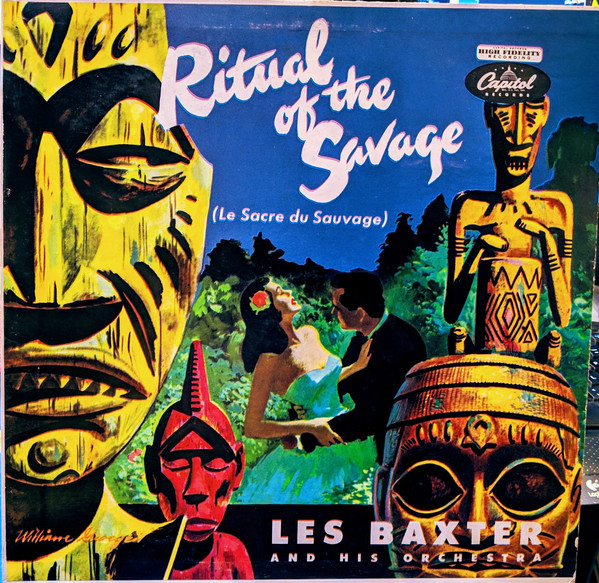Les Baxter – Ritual of the Savage
Released: 1951
Ritual of the Savage is an album by American composer Les Baxter, released in 1951 often cited as one of the most important exotica albums. The album features lush orchestral arrangements along with tribal rhythms and offered such classics as “Quiet Village”, “Jungle River Boat”, “Love Dance”, and “Stone God.”
Nowadays, there may be some who would have issues with the general concept, which is understandable. The world has in many ways changed since 1951, and, unfortunately, in many ways hasn’t

Baxter described the album as a “tone poem of the sound and the struggle of the jungle.” The album’s liner notes requested the listener to imagine themselves transported to a tropical land.
“Do the mysteries of native rituals intrigue you…does the haunting beat of savage drums fascinate you? Are you captivated by the forbidden ceremonies of primitive peoples in far-off Africa or deep in the interior of the Belgian Congo?”
One thing you may or may not have noticed relates to 1001 Other Albums – 1 – Yma Sumac – Voice of the Xtabay as Baxter is listed as the composer for Sumac’s album. I didn’t actually notice this myself until 5 minutes ago.
TRACKLIST
A1 Busy Port
A2 Sophisticated Savage
A3 Jungle River Boat
A4 Jungle Flower
A5 Barquita
A6 Stone God
B1 Quiet Village
B2 Jungle Jalopy
B3 Coronation
B4 Love Dance
B5 Kinkajou
B6 The Ritual
Interesting Facts About His Life and Work
- A Classical and Jazz Prodigy
Baxter studied piano at the Detroit Conservatory and later attended Pepperdine College. He initially wanted to be a concert pianist before shifting to arranging and composition. - Early Work with Big Bands
In the 1940s, he played saxophone and arranged music for big bands, including Mel Tormé’s Mel-Tones. This experience gave him a strong foundation in harmony and orchestration. - The Birth of Exotica
Baxter is credited with inventing the exotica genre with his 1950s albums, which blended jazz, classical, Latin rhythms, and sounds evoking faraway lands. His music painted sonic pictures of imagined tropical paradises.
Interesting Facts About the Album
- A Soundtrack for the Imagination
Unlike traditional jazz or Latin albums, Ritual of the Savage was designed to create a dreamlike atmosphere, evoking jungle landscapes, mysterious rituals, and tropical nights through lush orchestration. - “Quiet Village”—A Lasting Hit
The album’s standout track, Quiet Village, became a major hit and was later famously covered by Martin Denny, helping to define the tiki-lounge music craze of the 1950s and ’60s. - Experimental Orchestration
Baxter combined traditional orchestral elements with exotic percussion, bird calls, tribal chants, and Latin rhythms to create a hypnotic effect. This fusion influenced later lounge and film composers. - A Cinematic Influence
Though not a movie soundtrack, the album’s lush and dramatic sound was later echoed in many film scores, particularly in Hollywood’s portrayal of “exotic” locations in adventure and fantasy films. - A Foundation for Tiki Culture
The album became a soundtrack for mid-century tiki bars and lounge culture, influencing cocktail music and themed entertainment venues. - Later Influence on Pop Culture
In the 1990s, exotica music saw a revival, with Baxter’s work being rediscovered by collectors and musicians. Tracks from Ritual of the Savage have been sampled in modern music and used in films and commercials.

Leave a Reply